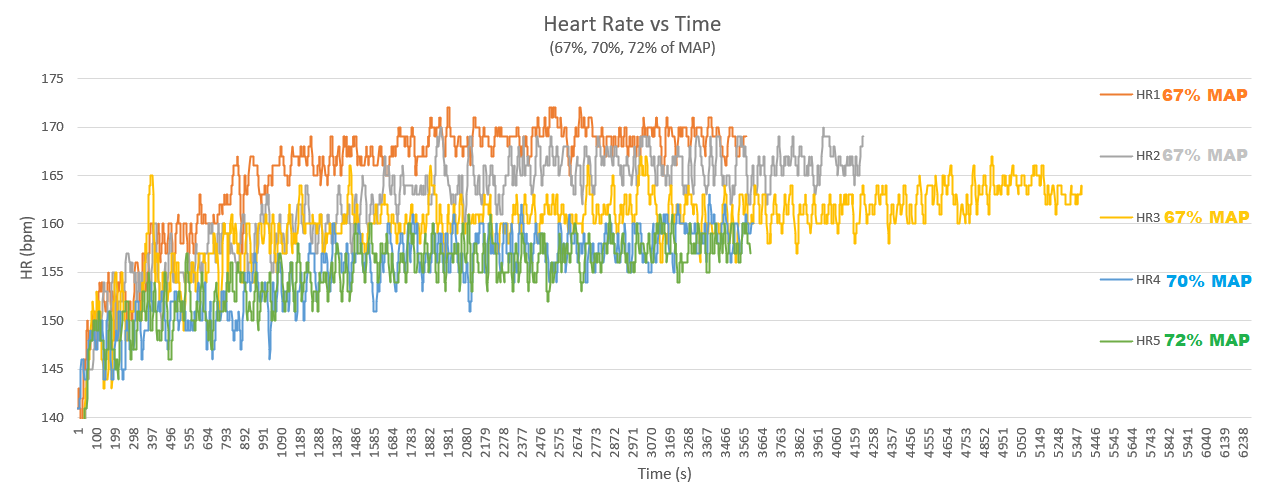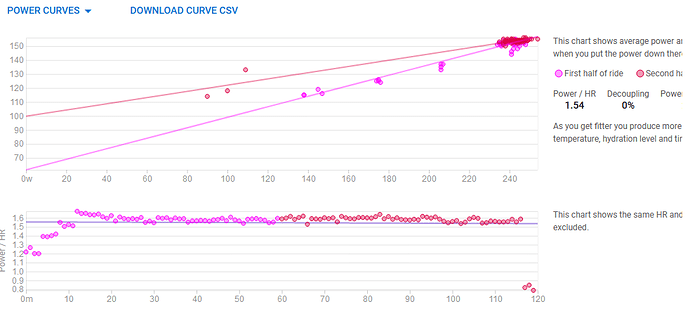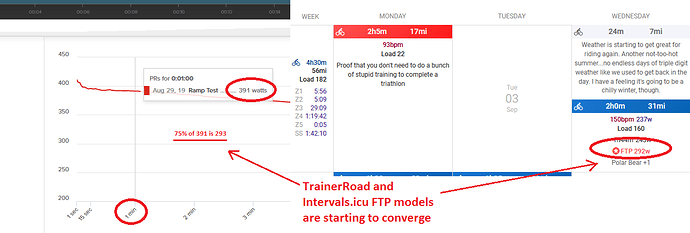That’s a good podcast. I’d never heard of that guy before that podcast.
One of my faves and I listen to it about once a month.
I’ve always had good sustainable power, but I’ve raised it in the last five years by “going back to the 90s.” I chucked my PMs from 2013-15. For those two years, I went back to training by heart rate.
My weeks looked like this:
Base: 3 rides where HR was in Friel zone 2 for about 90% of the ride. 2 active recovery days in HR zone 1. Two days with blocks of high tempo/low threshold in HR zones 3-4.
Build: 3 rides with HR in zone 1-2, depending on how I felt. One ride was always solidly in zone 2, drifting towards the upper range. 2 active recovery days in zone 1. 2 VO2 interval days.
I had the best form in a few years in 2015. Partly because weight was down, but what I had done going back to HR training worked better than the power-based training where zone 2 rides were always zone 2 power, I avoided too much tempo, and did lots of 2 x 20 and 4 x 4 VO2s.
When I returned to PMs, I trained like I had by HR and looked at the PM data post-workout. What I saw that I had been doing was doing most of my endurance training right at, or slightly above my AeT, and my base intervals had been 90-94% of FTP, rarely in the upper zone 4 range. I also saw that my AeT was usually 80% of FTP – so power zone 3 for me was Friel HR zone 2, and I could do a lot of it and still get faster (and when I started using Xert, their LTP – lower threshold power – turned out to be that 80%, so the point were starting to line up).
The short of it? I did as many 2-3 hour rides at 80% as I could tolerate, did some long 3-4 hour rides, and long (up to 120min) 90% FTP block rides during base. I would start with 60min @ 90% and add minutes until I was doing the 2hr+ ones. So, I was doing as much work as I could right at/slightly above AeT, and as much as I could at the level of maximal lactate clearance, 90% FTP. If you are willing to let go of the top end, that’s a way to build a big aerobic engine (look at that “how Bernal trained” thread).
TLDR: do a lot of high volume sweet spot base. then “polarize” and do the VO2 blocks. In other words, do what Arthur Lydiard said you should de, back in 1964…
Just did Polar Bear +1 again but this time using the 281W FTP mark from my Hour of Power attempt. That means a whole slug of all time power records but more importantly, check out the cardiac drift:
Zero percent. That means none ;-). First time I attempted this workout normalized power was 233W through the work set & cardiac drift was over 9%. Tonight workset normalized power was 244W and cardiac drift was 0%. While those are decidedly pedestrian power numbers everything is moving in the correct direction.
Also interesting that as I close the gap between TR MAP-derived FTP and what I can actually sustain for an hour…TrainerRoad and Intervals.icu FTP models are also converging:
Fantastic!
First of all, THANK YOU! This post describes me almost 100% accurately. Over-unders from SSBMV1 were extremely hard (bailed at two), but the forum said that’s how they should feel. I started to suspect that something is not quite right at the first week of SSBMV2. The ramp test I did this week gave a nice 6% increase from the beginning of SSBMV1. I was really happy… until I reached the end of the week and died at Kaweah. Then I started questioning my FTP from ramp test. Looking at it without euphoria of progress, it is obviously nowhere near what I could sustain for any longer period of time. At best, probably for 10 minutes.
You ended your post with “There is a solution!”. What should I do? Obviously lower my FTP. But what else? Should I start over with SSBMV1 to actually get aerobic workouts which I did not get the first time around (when I got a full dose of VO2max ones)? Or should I take a break from SSB plans altogether and work on increasingly long sustained efforts as are suggested in this thread? Any other suggestions?
Long, sustained power was my goal…so, first, you must contemplate what YOUR goal is. ‘The solution’ was 1.) Eliminate VO2max work because it was a waste of time, 2.) Find out what power I could hold for an hour & 3.) Based on THAT power do super long sweet spot intervals. Like Polar Bear and Phoenix.
If your goal is something like cyclocross and/or mountain bike…maybe you don’t need to do anything. Well, maybe just understand that the TrainerRoad MAP-based FTP test overestimates your sustainable power output & adjust sweetspot work accordingly.
Ok, DEFINITELY adjust sweetspot work accordingly. Otherwise ‘sweetspot’ will be suprathreshold & if you keep plugging away doing a lot of suprathreshold work it will have devastating consequences. Consider the case of a rider who tests a TR-Ramp-MAP of 300 but has actual FTP that is 65% of MAP. TR sets that riders FTP at 225 & the bottom end of SweetSpot @ 191. However the Rider’s actual FTP is 195 so the bulk of SweetSpot work is going to take place at or above FTP. That rider is going to destroy themselves trying to complete sweetspot base at a mid volume.
Same goal, long sustained power. I’ll try a Sweet Spot Base HV1 plan as it almost exclusively consists of sweet spot workouts. Using a more realistic FTP this time. The idea would be to gradually work towards longer and longer intervals, towards monsters like Phoenix and Polar Bear. Does that sound reasonable?
Thanks again!
Ouch.
Did you do your Hour of Power indoors, and if so what was your setup?. I’m thinking of tweaking the 20 min test to turn it into a 1 hr test.
@Brennus did you continue your sustained power experiment? If so, how did it go.
My first A race is a 100m TT in June (fingers crossed!) – I found this old post and it resonated. When I raced my first, and only, 100m TT in June 2019 my bread and butter session was to spend increasingly longer @ 160bpm (80% max; 20 beats below LTHR so bang in the middle of z3). Worked really well pre-PM!
Just to provide a tangible example of how this sort of sustained power progression can work.
Here is a rider who started the progression with an attempted interval @ 67.5% of MAP. 40 minutes into that interval average HR crept up over 92% of max so interval power was lowered until HR stabilized. Average power for the hour interval wound up being just a skosh below 67% of MAP.
That was probably just about TRUE FTP for this rider at that time.
Once a week for the next three weeks that hour workout was repeated in the exact same fashion. Except if HR held steady below 92% the rider was free to extend interval time 10 minutes or 20 minutes. Whatever felt doable.
Other ride time was at less than 60% MAP (much less) except for maybe half a dozen sprint efforts and one VO2max workout over the course of the month.
Here is the HR response of the rider during a month long progression of these workouts…orange is week one, grey is week two, yellow is week three. 67.5% of MAP has gone from being at or just a little bit over FTP to being definitely less than FTP in just a few weeks.
This is very impressive!
Interesting. 67.5% MAP should be ~90% FTP based on how TR works it out
Yeah. A difference of about 30 watts in this case.
Now, imagine if this rider was asked to do Kaweah a few days after their Ramp Test. They would be doing 10 minute intervals at 105% to 110% of their true FTP. That’s a VO2max workout. A hard VO2max workout.
I’d much rather to an hour at FTP than Kaweah at 110% of FTP. Yikes.
tofel said:
And I agree. Those results are profound but they are not exceptional. Those results are typical if you know how to do it. ![]() So to all you riders out there that just took a ramp test and got clobbered by Kaweah a few days later…here’s something you can do.
So to all you riders out there that just took a ramp test and got clobbered by Kaweah a few days later…here’s something you can do.
How was the athlete training before starting this progression?
t/th/sat race rides. A very good sprinter that felt like he was struggling if other riders coordinated to make the ride tough. Race rides are off so we started riding together remotely. As absurd as that sounds.
So I just saw this resurrected thread for the first time and it peaked my interest because I have similar goals but am coming from the complete opposite side of the training spectrum. I have done tons of Z2-SS work in the last few years and very little over threshold. I am excellent in the back half of any race over 4-5 hrs but last year noticed that my lack of short, repeatable power was holding me back
I am the guy who can do 250-260W forever (about 3.6-3.7w/kg for me) but can’t do 400W for 2-3 minutes more than a couple of times before dying.
Last year at a gravel 100 I got dropped from the leaders in the first hour as a result. My guess is I put up a higher total average w/kg to get 4th than I would have to get 2nd if I could have held the moves early.
This year I am putting an early focus on supra threshold/Vo2 work and yesterday set an all-time 6min power record during Denali +4. Long way to go, here’s to you and I meeting in the middle!
Continue to be surprised how two riders with very different physiologies (a sprinter and an ultra cyclist) can have such a similar response to training. The last two weeks we kept interval time constant at 60 minutes and raised intensity.
HR response has been very good…as you can see on the chart. I think we’ll bump it up to 75% next week. For me it’ll be the first time I’ve ever actually ridden for an hour at 100% of my TR FTP.



